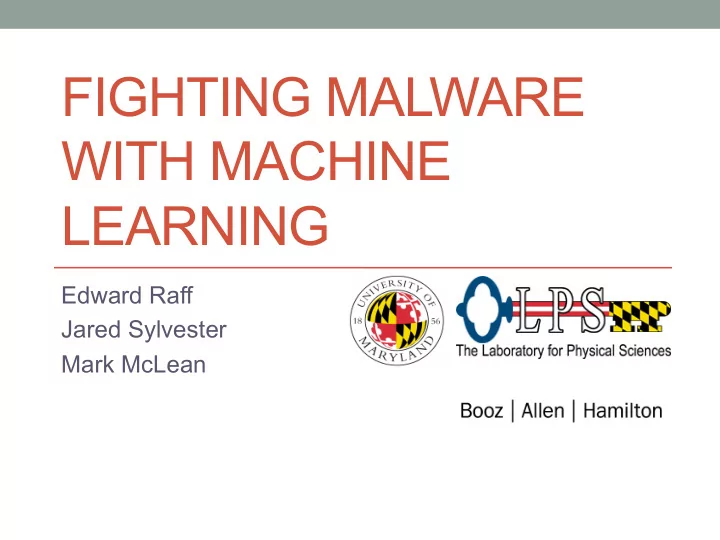

FIGHTING MALWARE WITH MACHINE LEARNING Edward Raff Jared Sylvester Mark McLean
Need ML for Malware • Amount of malware is growing exponentially • Anti-virus and signature based approaches are reactionary, don’t work for novel malware • Current approaches are labor intensive and require smart analysts • Machine Learning has the potential for a pro-active solution, but it’s a hard problem
Difficulties with Malware • Good labeling of data is hard • Requires domain expertise • Getting good benign data is especially hard • Variable length and large • A single binary could be a few KB to 100MB+ • Scale of individual data points is far beyond work in other domains • Real life adversarial scenario • Concept drift++ • Opponent’s behavior is unbounded
Even More Difficulties with Malware • No real meaningful transformations • Can’t do augmented training, can’t “resize” a binary, … • Many modalities of data • Header, code, data, etc, all behave and are represented differently • Meaning of a byte is entirely context dependent • Difficult locality behavior • Spatial locality is often disjoint (think branching) and globally invariant (code sections could be re-arranged almost arbitrarily)
Progress towards ML for Malware • We want to fight malware using Machine Learning and minimal domain knowledge • Its expensive, and malware doesn’t always play nice • Much prior work using things like n-grams, but many results are plagued by data quality issues • See: “An Investigation of Byte N-Gram Features for Malware Classification,” to appear in Journal of Computer Virology and Hacking Techniques • Deep Learning provides a likely solution • Short term: Get the easier cases right, and use ML to assist analysts on the harder ones
Small-Scale Results: Using PE-Headers • Compared a Neural Network approach to a Domain Knowledge (DK) using a portion of the PE-Header • Neural Networks performed better on every test set • Higher AUC provides better rankings • Validates that neural networks can learn from just byte sequences • Also trained an attention LSTM, and used the attention to confirm similar items were being learned • Took 11 days of training time for each model using a Titan X Test Set NN Accuracy DK Accuracy NN AUC DK AUC A 90.8% 86.4% 0.977 0.972 B 83.7% 80.7% 0.914 0.861
Why we care about attention Good /Bad? Attention Mechanism LSTM
Why we care about attention Good /Bad? Attention Mechanism 0.1 0.6 0.25 0.05
Current Research and Goals • Can we replicate this on the entire binary? • Combine Convolutional & Recurrent Networks • Use RNNs to handle the variable length of binaries. • Problem is too big to learn byte-by-byte: over 2 million time steps! • Use Convolutions to help us process many bytes at a time and exploit the locality we can • Considering entropy and other high level structure to help infer a decision • Use attention to ignore parts of the input • Helps us infer which portions of a binary may be malicious when trained with only coarse labels
Final Architecture Good Fully Connected /Bad? Extra Context Attention Mechanism RNN RNN RNN RNN CNN CNN CNN CNN Chunk of bytes Chunk of bytes Chunk of bytes Chunk of bytes
GPUs are 100% necessary • Our initial tests are pushing the limits of what we can do with GPUs today • On 12GB cards, max batch size of 6 • We’ve already made our model smaller than desired to fit onto a GPU • Training currently takes over 4 days for a single epoch on new M40s
Recommend
More recommend